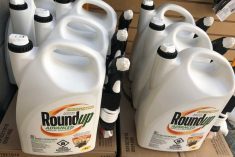In the war between canola producers and clubroot, clubroot is winning.
“The clubroot-infested area is spreading at roughly about 30 kilometres a year, and we’re only managing it at 20 kilometres a year,” said Dan Orchard, agronomy specialist for the Canola Council of Canada.
“We got an appreciation this year for just how fast it can spread. We’re way behind it — chasing it out rather than choking it in.”
Clubroot was first discovered in central Alberta in 2003, and since then has spread to more than 1,000 fields in over 30 counties. Last month, it was discovered for the first time in the Peace region (in Big Lakes County). Canola industry officials are still trying to trace how the disease moved into the area, as well as which strain of clubroot it is.
- Read more: Clubroot climbs up into the Peace region
- Read more: Clubroot ‘heavily’ infests NW Saskatchewan field
But for Sexsmith-area producer Greg Sears, that rapid spread is a wake-up call.

“Anything as ominous as clubroot is worrying when it’s spreading at any rate — but certainly, it’s covering a lot of ground quickly, and it doesn’t give us a lot of time to look at our practices and make the changes we need to,” said Sears, chair of the Alberta Canola Producers Commission.
Even so, Sears calls clubroot’s spread north “inevitable.”
“There’s nothing magical about our soils that would prevent clubroot from migrating here,” he said. “It’s unfortunate that it’s been identified, but I think it was inevitable.”
That’s partially because “there’s a certain level of denial” about clubroot, especially in areas that haven’t been affected by the disease in the past.
Read Also

Moo translator and methane measures: There’s an app for that
Dalhousie University researchers use artificial intelligence to create new dairy farm apps that analyze cattle sounds and measure methane.
“There are a lot of crossed fingers that clubroot isn’t going to make it into the area,” said Sears.
But crossed fingers aren’t enough to slow the spread of the disease, and many producers don’t want to risk losing canola as a cash crop by changing their management practices or extending their rotations.
“Canola-cereal rotations have become a very desirable rotation,” said Sears. “Canola works well on people’s operations. It’s a great crop to grow, both from a revenue standpoint and with the herbicide options for cleaning up land.
“It’s pretty hard to give that up.”
‘Going to hurt’
But the rapid spread of clubroot may soon force their hands.
“In the Peace Country, we’ve relied quite heavily on canola as a good-income crop, and if we don’t get on top of it early, we’re going to see our ability to grow it on a regular basis diminished,” said Sears. “When you’re used to having canola income every two or three years off a piece of land and you end up going to every five or six because clubroot becomes that much of a problem, that is a significant issue.
“That’s going to hurt quite a bit, especially up here in the Peace Country where we don’t have a lot of alternative crops.”

Clubroot “isn’t going to go away in a heartbeat,” added Canola Council agronomist Gregory Sekulic, who’s based in the Peace.
“It’s something we’re going to have to manage quite aggressively in the short term, and honestly, we’re going to have to do a better job of managing it than we have been,” he said.
“It’s not a surprise that we found it, but now that it’s here, growers do need to be that much more cognizant of managing it.
“We really want growers to assume that all fields have clubroot.”
The first step is growing a resistant variety.
“Once the disease has been identified on your field, look into resistant varieties immediately,” said Sekulic. “You need to switch all of your varieties to resistant varieties. Period. That goes for growers in the immediate vicinity as well.”
Orchard agrees.
“These fields we’re now finding are all susceptible varieties,” he said. “By the time they’re discovering it, the crop is dead in huge areas. The amount of spores in the soil is astronomical, and it now becomes a difficult disease to manage.
“When other counties are diligent and finding it really, really early, the management list is far more extensive.”
Managing disease resistance
But producers also need to manage disease resistance in their varieties.
“Use the same resistance too often and it won’t work. It’s like an antibiotic that you repeatedly take that eventually doesn’t work,” said Orchard.
“That’s what’s happening in the areas with really high spore loads and canola every second year with the same genetics.”
It only takes about two crops of a resistant variety for the pathogen to start to shift to overcome it, said Murray Hartman, provincial oilseed specialist.

“If you start growing a resistant variety before you know there’s any symptoms, you can probably grow that crop three or four times,” he said. “But if you wait until you’ve got the patches, you’re only going to grow it twice before you’ve got these new strains.”
That’s why officials say “don’t grow a resistant variety more than once every four years.”
“Two crops would give us almost 10 years to breed new varieties,” said Hartman. “Unfortunately, we had guys growing them back to back, and within three years, the resistance was starting to fail in spots.”
Extending the crop rotation “isn’t so much about yield penalties or agronomics — it’s to protect resistance,” said Orchard.
“If you’re on a two-year rotation, then it’s four years before your resistance doesn’t work anymore,” he said.
“The longer you stretch out your rotation, the longer you’ll have until the resistance doesn’t work. You’ll get the same number of canola crops out of that field. It’s just whether you want to stop growing canola in four years or eight.”
Other best practices
Extending the crop rotation comes with other benefits as well, said Sekulic.
“For disease management, a longer rotation is going to be better,” he said. “We definitely want to encourage growers to introduce as much diversity into their fields as possible. The longer a field is out of canola, the fewer spores that will be in it.
“Once clubroot is found, we absolutely need to stretch our rotations to at least one in four.”
Sanitation should also be “first and foremost in producers’ minds,” he added.
“When they’re travelling from field to field, they need to make sure their soil stays at home,” he said. “And when we’re bringing equipment in from other parts of the province, we really want to make sure that it’s been pressure washed aggressively, ideally with a bleach solution to kill any spores.”
Incorporating those management practices might be a hard sell for producers who can’t afford to extend their rotation or stop during a busy harvest to sanitize their equipment. But ultimately, the future viability of canola as a crop may depend on it, said Sears.
“It is hard to stop at the end of the field before going to the next one and get rid of all the excess dirt. And it is hard to try a new crop,” said Sears.
“But clubroot is a very significant and very real issue for us in Canada, and I think you just have to close your eyes and imagine what your farm would be like if you couldn’t grow canola.
“It’s one of those tough choices that we need to make.”
And those tough choices need to be made sooner rather than later.
“You can’t switch from a one-in-two rotation to a one-in-four rotation overnight. We need to start making those changes right away so that we’re ready for it.”















